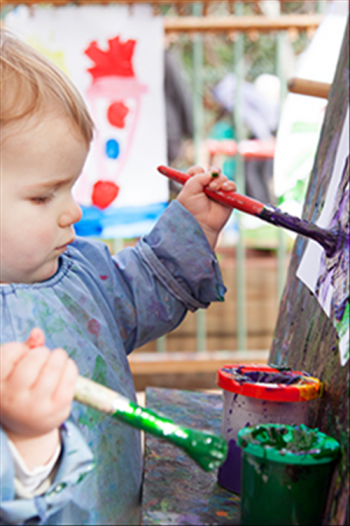Painting
Duration/age

Painting is a wonderful activity that can be enjoyed inside and outside and does not always need to include paint. On a hot day painting could be a bucket of water and a paint brush, making designs and swirls on the path, watching to see how quickly the hot sun makes the water disappear.
Shaving cream is another wonderful substitute for paint. Your child can spread and move the shaving cream across the table with their hands and fingers. Encourage them to smooth the shaving cream out flat and draw pictures in the flat surface with their fingers.
Clear glue (cell mix) mixed with a little bit of water and food colouring can also make wonderful paint. Using cell mix also allows you to add collage pieces to the experience as the glue will help the pieces stick to the paper. Add a variety of thick and thin brushes and experiment with what else could be used as a brush.
What marks would a stick or a chopstick make on a page? What would happen if you used a bottle brush or the dishcloth?
Materials you will need
- Paint
- Paper
- Smock
- Water
- Brushes
Alternative tools
- Bucket
- Shaving cream
- Vegetable dye
- Clear glue
Skills this activity improves
Why does this matter?
Experimenting with paint helps children to develop motor skills in their hands and body. It also allows them to experiment with different ways to express their ideas through pictures and patterns. Through painting children experiment with space and placement of their ideas on the page, exploring how to make an object large or small, or adding patterns and details that add meaning to their ideas. Once finished children have the opportunity to share what they have done and to engage in social language, giving them the opportunity to develop communication skills.
What does this lead to?
Through painting children are developing language to describe what they know and have seen. As they attach language to their picture or experiment with colour they are developing an understanding that pictures can also tell a story.
Language to use
- Thick, thin, long, short
- Up, down, across, under, between
- Green, red, blue, yellow
- Start, finish, ready, completed
Questions to use
- What are you painting?
- Is this an inside or an outside picture?
- Who is in the picture?
- Is it a daytime or a night-time picture?
Useful tips
- An old adult shirt makes a great children's painting smock.
- If clothes get paint on them, wash them in cold water. Hot water helps to set the paint.
- Use paintings as gift wrap.
- Cell mix is available from Bunnings
- Remember to talk to your child in your home language.
More ideas
- Use factual books as a resource to extend children’s ideas.
- Add collage pieces to the painting experience.
- Write the story of the painting on the bottom and encourage your child to copy the words.
Variation by age
Birth to two year old
- Use thick brushes as these are easier for little hands to hold.
- Tape the paper to the fence for painting.
- Mix sand, dirt and water together for textured painting on a table.
- Sing songs as you paint to help your child decide which way to move the brush, for example up up up, down down down.
Three to five year olds
- Use factual books, like books about birds, as a resource to extend your child’s ideas.
- Add collage pieces to the paining experience.
- Write the story of the painting on the bottom and encourage your child to copy the words
Questions to use
- What are you painting?
- Is this an inside or an outside picture?
- Who is in the picture?
- Is it a daytime or a night-time picture?


